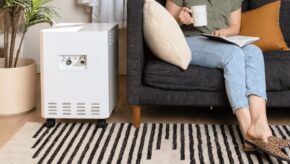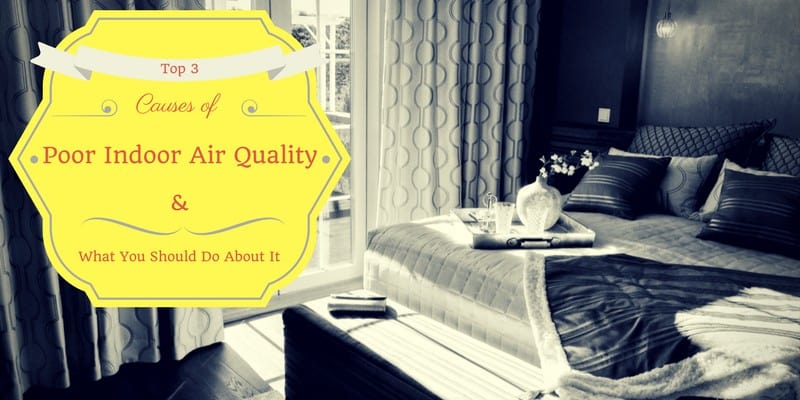Many people may suffer from allergy-like symptoms that they’re unable to explain. They may experience a sore throat, itchy eyes, fatigue, and other symptoms. Poor indoor air quality may be to blame. Until recently, people who complained of such subjective overlooked symptoms, but scientists slowly recognize poor indoor air as a real health problem.
Symptoms Associated with Poor Indoor Air Quality
 Symptoms of exposure to toxic air can present itself in many ways. They can include acute effects like watery eyes or a headache or can be long-term problems like chronic fatigue. In either case, it may not be immediately apparent that indoor pollutants cause the symptoms, and people may continue to suffer and point to other sources as the cause of their symptoms.
Symptoms of exposure to toxic air can present itself in many ways. They can include acute effects like watery eyes or a headache or can be long-term problems like chronic fatigue. In either case, it may not be immediately apparent that indoor pollutants cause the symptoms, and people may continue to suffer and point to other sources as the cause of their symptoms.
The main symptoms associated with poor indoor air are ear, eye, nose, or throat irritation, dry skin, rashes, headaches, unexplained sleepiness, coughing, respiratory problems, hoarseness, and nausea. Everyone’s bodies react to certain substances differently, so one person may have a severe reaction to poor indoor air, while another may notice few to no symptoms.
About Indoor Air Pollution
There’s often a lot of commotion about pollen, dander, or other sources of allergies that come from the outdoors. Pollen alerts are issued by weather stations to warn those with allergies to stay indoors. Many don’t know, however, that in most cases indoor air is much more hazardous to our health than outdoor air. Many homes, offices, stores, and other buildings contain a high level of volatile chemicals within their walls. From the carpet to the drywall to the paint, these building materials emit chemicals into the air that become more concentrated over time due to the closed in environment. Modern construction that is efficient at keeping outdoor air out can magnify this concentration even more.
Between 40 or more hour work weeks and spending our nights and weekends in our homes, the average American ends up spending over 90% of their time indoors. It’s no surprise that members of the same family or co-workers in the same building often experience illness at the same time. This problem could correlate to the periods in which indoor air pollution in the places they co-mingle is at its worst. With all this time spent indoors, many companies also take a hit when it comes to worker productivity if they’re not feeling well from being exposed to all these chemicals.
Poor indoor air quality comes from the chemicals present in building materials and furnishing, but can also arise from other factors. Regardless of the pollutants present, one of the biggest factors is the lack of ventilation in most buildings. In many homes and most businesses, windows or doors that they didn’t leave open often enough to allow clean air to circulate through and carry toxins out. The chemicals inside buildings often come from new products like new carpet or furniture that, when opened or installed, emits volatile organic compounds (VOC’s) into the air. Without ventilation, instead of dissipating those VOC’s become more concentrated and dangerous. Other sources of indoor pollution can come from similar types of chemicals given off during a production of goods, from office machinery, or from biological organisms or bacteria from humans that become airborne and trapped indoors. If a worker in a building or resident of a home feels significantly better when they leave the environment, then that’s a clear indicator that something’s wrong with the indoor air quality.
How to Find Out if Indoor Air Quality is a Problem
 If you’re a homeowner or business, it’s important to know whether or not your building poses a risk to those in it. It can be a liability risk to operate a business that unnecessarily exposes employees and customers to hazardous conditions. Likewise, no homeowner wants to expose their family to polluted air either. There are several ways you can gauge the quality of the air, so you can develop a plan of what to do in case action is necessary.
If you’re a homeowner or business, it’s important to know whether or not your building poses a risk to those in it. It can be a liability risk to operate a business that unnecessarily exposes employees and customers to hazardous conditions. Likewise, no homeowner wants to expose their family to polluted air either. There are several ways you can gauge the quality of the air, so you can develop a plan of what to do in case action is necessary.
The best way to determine if there’s the problem, survey those who spend a lot of time in the building. In a home, if you and your family all have headaches, sore throats, or other chronic symptoms that may seem to be synchronized, it may be a good indication that something’s wrong with the air. Similarly, if a group of people who work together all are sick at the same time, the source of their illness is likely coming from the place where they spend time together. If surveying employees of the business, it’s a good idea to log any reported illness or symptoms formally. It also may be prudent to interview them multiple times to detect a trend or lack thereof in their symptoms.
The next thing to do is to examine and get to know the building’s ventilation and HVAC system. Businesses that produce goods and deal with a lot of manufacturing equipment may also have extensive exhaust systems. It’s important to find out what the ventilation rate it. Doctors recommend that at least five cubic air per minute, to circulate outdoor air throughout the building for every person inside. If you have access to the proper equipment, you can also measure the carbon dioxide levels indoors and directly outdoors over the span of a few days to detect, if there’s a significant difference between inside and outside. As a general rule, the air indoors shouldn’t contain more than 700ppm of carbon dioxide higher than the free level.
After checking out the ventilation system and whether or not there is enough circulated outdoor air throughout the building, you should check for other irritants such as mold and mildew. Mold can hide in damp, wet places, and can cause respiratory problems and allergy-like symptoms. Some people suffer for years from exposure to mold without realizing the source of the problem, until after they’ve spent a lot of money on unsuccessful medical treatment. Check for mold any place water may be present, such as in bathrooms, kitchens, or storage areas.
What You Can Do to Improve Air Quality
 If you have determined there’s a problem, you must now take the necessary steps to start mitigating the poor indoor air problem. As noted above, the first thing to do is to ensure proper ventilation. Many illnesses caused by poor indoor air can be alleviated or prevented, just by making sure fresh air has a chance to circulate through the building. Open windows and doors when possible. Check the exhaust system to make sure it’s working properly. Change filters in HVAC systems regularly. All of these steps can reduce the concentration of harmful VOC’s in the air. After taking these measures to improve ventilation, survey occupants and recheck carbon dioxide levels again to make sure the pollution level is going down.
If you have determined there’s a problem, you must now take the necessary steps to start mitigating the poor indoor air problem. As noted above, the first thing to do is to ensure proper ventilation. Many illnesses caused by poor indoor air can be alleviated or prevented, just by making sure fresh air has a chance to circulate through the building. Open windows and doors when possible. Check the exhaust system to make sure it’s working properly. Change filters in HVAC systems regularly. All of these steps can reduce the concentration of harmful VOC’s in the air. After taking these measures to improve ventilation, survey occupants and recheck carbon dioxide levels again to make sure the pollution level is going down.
What causes poor indoor air quality
You can make changes regarding what products are used inside the office or home, and what type and when remodeling occurs. If completing a massive remodeling project where paint, varnish, new carpet, or other chemical-laden materials will be installed, schedule the project when the least number of people will be present in the building.
After making sure to take these precautions, indoor air pollution may still linger. An optimal solution is to pair these measures with the use of high-quality air purification and filtration. Even with extra ventilation and care to use less toxic goods, indoor air pollution can remain. EnviroKlenz offers a line of products that are meant to combat indoor air pollution, whether it’s due to chemicals, pollen, dander, biological substances. The EnviroKlenz HVAC Filter for Chemical and VOC Removal is a HEPA filter that can be
The EnviroKlenz HVAC Filter for Chemical and VOC Removal is a filter that can be used in a home’s or business existing HVAC system but is far more advanced than a standard HVAC filter which focuses on particulate removal. It uses a proprietary blend of earth mineral technology to not only trap these harmful chemical and malodors but more importantly destructive adsorbs them and breaks them down on a compound level.
For the most thorough air purification, we recommend the EnviroKlenz Mobile system. This product is a portable unit that can cover up to 1000 square feet. It utilizes a two-stage filtration with the EnviroKlenz patented VOC cartridge which provides chemical odor neutralization. In addition to its odor neutralizing capabilities, the EnvioKlenz mobile comes equipped with a medical grade HEPA filter for particulate removal of up to .3 microns.
4-speed controls
Comes with EnviroKlenz Air Cartridge & HEPA filter
Height: 19: x Width: 15” x Depth: 15”
Net weight: 38 lbs (17.1 kg) – Shipment weight: approx. 45 lbs (20.5 kg)
Cord length: 5 feet (7.6 M)
Power: 115V / 60Hz / 1 amp
CFM Rating: 85, 150, 200 & 250
EnviroKlenz Mobile Air System, 250 CFM Type – 115V
By being proactive and assessing the situation, you can catch indoor air problems, before they do even more damage to the health of those who are exposed. Combining measures like improving ventilation and exhaust systems with state of the art air filtration technology like EnviroKlenz, unnecessary illnesses and allergies you can prevent.
Our Recommended Solution…

The EnviroKlenz Mobile Air System is your solution to removing VOCs and chemical pollutants from your indoor environment. With the use of a hospital-grade HEPA filter and an effective earth mineral technology air cartridge, this two-stage filtration is perfect to place in your indoor space to mitigate potential hazards to your health. Whether you have chemical sensitivities, allergies, or are just looking to improve your indoor air quality, the EnviroKlenz Mobile Air System is your answer!
- Simple and Easy to Set-Up, with Minimal Maintenance
- Replace Air Cartridge every 4 to 6 Months
- HEPA Filter Replaced Every Two Years
- Quiet Operation, 4-Speed Motor
- No Chemical Odors Released!
We are confident that our EnviroKlenz Technology will drastically reduce the odors in your home, if it doesn’t live up to your expectations, we will issue a full refund within 30 days of your purchase!
Click below to buy NOW!
Hear What People Are Saying About Us…..









